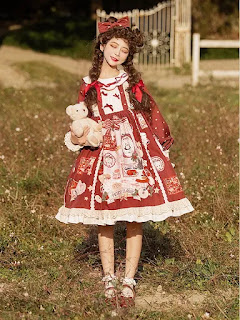🍓🍓🍓🍓🍓
Big Brand: A lolita fashion brand affiliated with a major company. Opposite of indie brand.
Bolero: A light jacket usually worn over a JSK for modesty or to keep warm. Used in spring, summer, and fall.
Community: A group of lolitas that live in similar geographical areas or share similar interests or styles come together to form "communities". These communities often have meetups and tea parties together, online or in person.
Coord/Coordinate: An outfit a lolita puts together, usually including a JSK, SK, or OP; blouse (if necessary), bag, accessories, legwear, and shoes.
Cutsew: Abbreviated form of cut and sewn, referring to clothing made out of jersey fabric.
EGL: Elegant Gothic Lolita; the branch of fashion that lolita exists in.
High Waist: Some lolita dresses come in a variety that is considered "high waisted". There are usually two types of high waist: regular and breast high. This waist type is usually created with an Asian body type in mind.
Indie Brand: A small, independent lolita fashion brand that is not affiliated with a major company. Opposite of big brand.
JSK: Jumperskirt; the most common type of lolita dress (usually with thin straps) that a lolita wears a blouse under. It can be long or short length.
KC: A headband, often with a large bow. They are usually designed with the same pattern of a dress and are therefore sold together. It is short for katyusha.
Low Waist: Also known as drop waist or normal waist, low waisted dresses typically align with the waist of an individual with a Western body type. In other words, the bodice is longer than in high waist dresses.
Meetup: A casual gathering where two or more individuals wear lolita together to go shopping, go to museum, have tea, or similar. Sometimes, this involves a theme, matching coordinates and/or dresses, or both.
Offbrand: An item that is not of any lolita fashion brand. It may originate from a second-hand store, Amazon, dollar store, etc., but it still holds the lolita aesthetic. These items are commonly used in daily coords.
OP: One piece; a dress that a lolita may wear without a blouse underneath.
OTKs: Over-the-knee socks.
OTT: Over-the-top; refers to lolita coordinates that contain more elements than what is considered typical, for example, the inclusion of extravagant petticoats, wigs, and accessories.
Print: The design on a lolita dress.
Salopette: A dress-like garment usually with two straps that are able to detach and adjust, similar to a pair of overalls. Usually, it is seen as a less formal version of a main piece.
SK: Skirt; worn with a blouse. Like salopettes, they are often seen as less formal than a JSK or OP.
Tea Party: A mass formal gathering of lolitas, usually involving a tea party and a fashion show. This can also refer to a smaller (but still formal) gathering such as a birthday party.
Twinning: When two or more lolitas wear the same coordinate or dress. This may be planned or unplanned.
Styles of Lolita
All credit for the images above belong to their rightful owners. Left to right: classic lolita, sweet lolita, gothic lolita.
Now that you are an expert in casual lolita expression, now I can elaborate on the various styles of lolita. There are numerous styles, but they are usually grouped into three common categories:
Classic: Classic lolita fashion is best described as mature, elegant, and refined. It is additionally more historically inspired than other styles. Solid dresses are common, but classic prints often include themes such as crowns, portraiture, classical paintings, flowers, music, and scenery. Common colors include burgundy, navy, brown, green, cream, and ivory. Popular brands that produce classic pieces include Victorian Maiden, Mary Magdalene, Innocent World, and Juliette et Justine.
Gothic: Gothic lolita is inspired by, hence the name, goth culture. It is mature and dark. Black is the most common color, but other dark colors are also included on occasion. Common prints include ravens, crosses, graveyards, dolls, and classical paintings. Moi-Meme-Moitie, Atelier Pierrot, and Atelier Boz all produce gothic pieces.
Sweet: Sweet lolita is the possibly the most common style of lolita. It is a whimsical, "kawaii" way of dressing. Prints often include cute motifs such as animals (notably bunnies and cats), desserts, seashells, girly objects (perfume, makeup, etc.), ribbons, fruit, and toys. Common colors include lots of pastels: lavender, pink, light blue (sax, short for saxon blue), white, yellow, and mint; black and brown are less common. Popular brands that produce sweet lolita include Angelic Pretty, Baby, The Stars Shine Bright, and Metamorphose Temps de Fille.
Other substyles include, but are not limited to:
- Country
- Ero (love-inspired)
- Guro (grotesque)
- Hime (princess)
- Kuro (all black)
- Old School (original version of the fashion, before prints were common)
- Ouji (prince, boy-like style)
- Sailor
- Shiro (all white)
- Steampunk
- Wa/Qi (traditional Chinese or Japanese style)
Poppy






No comments:
Post a Comment